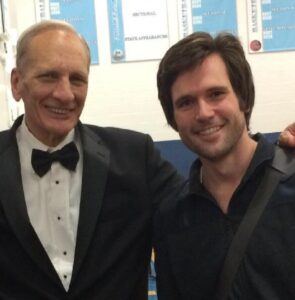Stop Trying to Be Your Old Band Director
It’s perfectly acceptable to borrow and copy teaching techniques from a mentor, but at some point, you need to forge your own path to best reach your students.
“You sound just like your old band director.” This was meant as a compliment. I knew that. But I still flinched when I heard it.
I was in my second year of teaching, and we were one week out from a performance. I was running around like a stressed-out version of the teacher who trained me — same phrases, same gestures, same “you-better-have-your-music-marked” tone. I was doing everything the way that I had been taught.
It wasn’t working.
My students were going through the motions. I was just checking boxes and getting increasingly frustrated. At the end of rehearsal, I sat in my office and stared at my lesson plan. It looked good on paper. So why did I feel like I was failing?
The truth was simple and uncomfortable: I was trying to run someone else’s program. And it was time to stop.

Mimicry Is Survival … Until It Isn’t
Let’s give ourselves some grace: Copying is how most of us start (and I’m not talking about being a copy-machine gopher during student teaching). It’s not laziness — it’s survival. In your first year or two of teaching, you’re handed a hundred spinning plates with very little instruction. So, you do what you know: You imitate.

I copied my old band director, Ted Lega, who was an incredible teacher, the kind people write entire tributes about. I copied his cadence, his rehearsal structure and even how he held his baton. I had zero shame about any of this — I was proud of it. I felt like I was honoring Mr. Lega’s legacy while holding it together long enough to survive the day.
The bad news is that mimicry has a shelf life.
Eventually, I hit a point where I was no longer confident; I now felt constrained. I was frustrated when something didn’t work — not because it was a bad strategy, but because I had no idea why I was doing it in the first place. None of it was rooted in my students, my school or my instincts. It was just a script that I had memorized.
Every new teacher will eventually run into this situation. The point where imitation no longer answers the question, “What do these kids need from me right now?”
That question can’t be answered by channeling someone else. It can only be answered by you.

The Blueprint Doesn’t Fit the Building
There’s a dangerous assumption built into early teaching: If you do what worked for your mentor, it will work for you, too. Unfortunately, teaching isn’t plug-and-play. Context is everything.
Your old band director may have had a decades-long legacy, multiple feeder schools, an auditorium that didn’t leak and maybe a full-time assistant. Or maybe he or she didn’t.
None of this matters. Look at what you have — 50% attendance, no budget and a practice room that doubles as a storage closet.
I tried recreating my mentor’s exact rehearsal plan with students who had never even played in middle school. I handed them the same scales, the same chorales, even the same warmup sheet — typed out in the exact same font. These students weren’t connecting with the process. Not because they didn’t care, but because the process wasn’t designed for them.
One of my percussionists finally asked me, “Why are we doing this again?”
I didn’t have an answer — just a vague “this is how it’s done.”
That moment stuck with me. I was prioritizing tradition over intention. I was spending so much time trying to be “right” that I forgot to be present.
When I finally stepped back and started building routines based on what this group needed — not what my mentor’s program needed — I began to see a shift. We weren’t more advanced, but we were more connected. We were more honest. And it felt like we were building something together, not just rehearsing someone else’s legacy.
Also, I shouldn’t leave out this monumental fact: What I thought my teachers had was not even close to the truth. They didn’t have the perfect system. They went through more challenges than I imagined. I just saw their late-stage process and composure.
Look at it this way: Your grandparents may have a nice matching and complementary set of furniture in their living room now. What you didn’t see? The early years when their front room was decorated with an avocado green sofa, a burnt orange recliner and two mismatched end tables.

Find Your Own Voice, Even If It’s Quieter
Here’s what nobody tells you: Don’t be your mentor. You don’t need to be a legend. You just need to be someone real.
I stopped mimicking and started asking, “What actually works here?” That’s when I began to develop my own teaching voice. It wasn’t flashy or loud, but it was me. (OK — it was sort of loud).
Instead of repeating what I was told as a student, I started explaining concepts in ways that made sense to my current students. I asked for more input during rehearsals. I let go of the need to be the most important voice in the room. Guess what happened? My students started listening more.
I also became more open with my own process. I’d say things like, “I’m trying something new today. Let’s see how it goes.” Or, “This piece is new for me, too. Let’s figure it out together.”
That vulnerability changed the culture in our room. Students felt safer taking risks because they saw me doing the same. Eventually, one student told me, “You kind of remind me of my old band director — but you smile more, and you don’t yell.”
This wasn’t something that ends up being engraved on a trophy, but it made me pause. Because it meant I wasn’t invisible. I wasn’t an echo. I was becoming someone they’d remember for being me and doing things on my own terms.

What to Keep and What to Let Go
Honoring your teachers doesn’t mean copying them. It means learning from them and making choices based on your values, your students and your strengths.
Here’s a filter that helped me sort that out:
- Keep the values: If your mentor showed up early, stayed late and cared deeply about students — hold onto them because those values don’t expire.
- Adapt the methods: Rehearsal strategies, performance calendars, behavior systems — borrow them, but test them. If they don’t work for your students, don’t force them.
- Drop the guilt: This one’s huge. If you’re not marching a full show, if your sight-reading is rough, if you’re skipping a festival this year — it doesn’t mean you’re failing. It means you’re making decisions based on your current reality. That’s leadership, not laziness.
And here’s the simple truth: No one gets it all right. Not your mentor. Not your peers. Not even you, 10 years from now. Just remember to stay rooted in why you’re doing what you’re doing, and you’ll build a program that fits your students — and you.

You’re Not a Clone. You’re a First Draft
One day, you’ll be the teacher a student remembers fondly as “my old band director.” They won’t be comparing you to anyone else. They’ll remember how you showed up. How you explained things. How you looked out for them when they bombed a solo (thanks, Mr. Lega). How you gave them a second chance. How you taught them something that stuck.
They won’t care if your concert cycle looked like your mentor’s. They won’t remember if you used “Foundations or Essential Elements” or wrote your own warmups from scratch. They’ll remember you.
You don’t need to be a carbon copy of the person who inspired you. You just need to be consistent, thoughtful and honest. And if you’re not there yet, that’s fine too. Most of us aren’t. Because teaching isn’t about perfection. It’s about presence.
And you’re already doing that.















